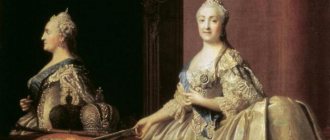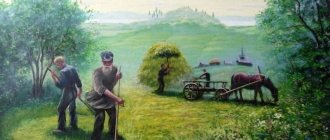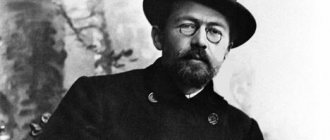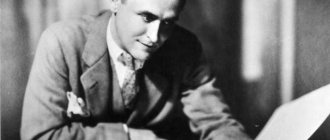Summary
Derzhavin’s ode “Felitsa,” the summary of which you are reading, received its name from the heroine of “The Tale of Prince Chlorus.” The author of this work is Empress Catherine II.
In his work, Derzhavin calls the ruler of Russia herself by this name. By the way, it is translated as “happiness”. The essence of the ode boils down to the glorification of Catherine (her habits, modesty) and a caricature, even mocking depiction of her pompous surroundings.
In the images that Derzhavin describes in the ode “Felitsa” (a summary cannot be found on “Brifley”, but it is in this article), you can easily recognize some of the people close to the empress. For example, Potemkin, who was considered her favorite. And also Counts Panin, Orlov, Naryshkin. The poet skillfully depicts their mocking portraits, while demonstrating a certain courage. After all, if one of them was very offended, he could easily deal with Derzhavin.
The only thing that saved him was that Catherine II really liked this ode and the empress began to treat Derzhavin favorably.
Moreover, even in the ode “Felitsa” itself, a brief summary of which is given in this article, Derzhavin decides to give advice to the empress. In particular, the poet advises that she obey the law, the same for everyone. The ode ends with the praise of the empress.
Bridge between fairy tale and ode
In front of them was a steep mountain, without paths or stairs. Apparently, the prince himself was quite persistent, because, despite enormous work and trials, he still climbed to the top, where he decorated his life with a rose without thorns, that is, with virtue. An analysis of the ode “Felitsa” shows that, as in any fairy tale, the images here are conventionally allegorical, but in Derzhavin at the beginning of the ode they stand up very strongly, and all the odic beginnings of classical examples, where the ascent to Parnassus and communication with the muses are sure to fade next to with seemingly simple images of a children's fairy tale.
Even the portrait of Catherine (Felitsa) is given in a completely new manner, which is completely different from the traditional laudatory description. Usually in odes the honored character appears in the inexpressive image of a goddess, walking through the solemn, booming rhymes of the verse with heavy rhythmic shortness of breath. Here the poet is inspired, and - most importantly - equipped with poetic skill. The poems are not lame and are not inflated with excessive pathos. The plan of the ode “Felitsa” is such that Catherine appears before the reader as an intelligent, but simple and active Kyrgyz-Kaisat princess. The contrast in the structure of this image plays well with the image of Murza, vicious and lazy, which Derzhavin uses throughout the ode. Hence the unprecedented genre diversity that distinguishes the ode “Felitsa”.
Uniqueness of the work
Having read the brief content of the ode “Felitsa”, one can come to the conclusion that the author violates all the traditions in which such works were usually written.
The poet actively introduces colloquial vocabulary and does not shy away from non-literary statements. But the most important difference is that he creates the empress in human form, abandoning her official image. It is noteworthy that many were confused and disturbed by the text, but Catherine II herself was delighted with it.
Personality in ode
And also in the analysis of the ode “Felitsa”, the student can note the fact that Derzhavin also introduced a personal element into the work. After all, the ode also contains the image of Murza, who is sometimes frank and sometimes sly. In the image of nobles, contemporaries could easily find those close to Catherine who were discussed. Derzhavin also meaningfully emphasizes: “That’s how I am, Felitsa, depraved! But the whole world looks like me.” Self-irony is quite rare in odes. And the description of Derzhavin’s artistic “I” is very revealing.
Image of the Empress
In the ode “Felitsa” by Derzhavin, a brief summary of which contains the semantic quintessence of the work, the empress initially appears before us in the usual god-like image. For the writer, she is an example of an enlightened monarch. At the same time, he embellishes her appearance, firmly believing in the image depicted.
At the same time, the poet’s poems contain thoughts not only about the wisdom of power, but also about the dishonesty and low level of education of its executors. Many of them are only interested in their own benefit. It is worth recognizing that these ideas have appeared before, but never before have real historical figures been so recognizable.
In Derzhavin’s ode “Felitsa” (Brifley cannot yet offer a summary), the poet appears before us as a brave and courageous discoverer. He forms an amazing symbiosis, complementing the laudatory ode with the individual traits of the characters and witty satire.
Artistic synthesis
Analysis of the ode “Felitsa” shows the orientation towards the usual, solemn ode of praise for the date, accepted in those days. The ode is written in traditional stanzas - ten lines, and, as it should be, But before Derzhavin, no one had yet dared to merge two genres that were opposite in purpose - the majestic laudatory ode and the caustic
The first was the ode “Felitsa”. Derzhavin seemed to have “stepped back” in his innovation, judging by the precisely fulfilled conditions of the genre, at least in comparison with “Birthday Poems,” which are not even separated by stanzas. However, this impression disappears as soon as the reader gets through the first few stanzas. Still, even the composition of the ode “Felitsa” represents a much broader artistic synthesis.
History of creation
It was Derzhavin’s ode “Felitsa”, a brief summary of which is convenient for a general acquaintance with the work, that made a name for the poet. Initially, the author did not think about publishing this poem. He did not advertise it and hid his authorship. He seriously feared the revenge of influential nobles, whom he did not portray in the best light in the text.
Only in 1783 the work became widespread thanks to Princess Dashkova. A close ally of the empress published it in the magazine “Interlocutor of Lovers of the Russian Word.” By the way, the ruler of Russia herself contributed her texts to it. According to Derzhavin’s memoirs, Catherine II was so moved when she first read the ode that she even began to cry. It was in such moved feelings that Dashkova herself discovered her.
The Empress certainly wanted to know who the author of this poem was. It seemed to her that everything was depicted in the text as accurately as possible. In gratitude for Derzhavin’s ode “Felitsa,” a summary and analysis of which is given in this article, she sent the poet a golden snuffbox. It contained 500 chervonets.
After such a generous royal gift, literary fame and success came to Derzhavin. No poet had known such popularity before him.
Currently reading
- Summary of Bianca the Owl
A story about how an elderly man quarreled with an owl. He sat, as usual, sipping tea. Not just any tea - with cow's milk. Suddenly a gray owl flew in. I greeted the old man and called him a friend - Summary Chukovsky Alive as Life
In the work “Alive as Life,” created by Korney Ivanovich Chukovsky, the Russian language is explored. The text of the work is written in an interesting language that does not let the reader get bored. - Summary of the Boy with a Sword Krapivina
The story takes place at a small railway station. One day a little boy, Seryozha Kakhovsky, comes to this station. The child was alone, but those around him
Artistic features of the ode “Felitsa”
Derzhavin worked in the genre of classicism. This direction strictly forbade combining several genres, for example, high ode and satire. But the poet decided on such a bold experiment. Moreover, he not only combined them in his text, but also did something unprecedented for the literature of that very conservative time.
Derzhavin simply destroys the traditions of the laudatory ode, actively using reduced, colloquial vocabulary in his text. He even uses frank vernacular, which, in principle, were not welcomed in literature in those years. Most importantly, he portrays Empress Catherine II as an ordinary person, abandoning her classical ceremonial description, which was actively used in similar works.
That is why in the ode you can find descriptions of everyday scenes and even literary still life.
Literary joke
But the poet has no condemnation of the empress, who is surrounded by people with human weaknesses. After all, their talents are at the service of the prosperity of the great empire. This is shown by the analysis of Derzhavin’s poem “Felitsa”. The literary anecdote technique is used in the portraits of high-ranking courtiers. In those days, an anecdote was understood as a real story about a real person, but artistically processed, which has an instructive or satirical sound. Indeed, in the memory of descendants there remained a reveler, a duelist and a tireless ladies' man, the favorite of Catherine II, Alexei Orlov, a cautious Panin, a sybarite, but also a victorious warrior Potemkin. The gradual departure from the scene of the Freemasons, which began during the time of Catherine II under the influence of the bloody revolution that took place in France, is described. The Masons are mentioned at the very beginning of the ode. But in general, Derzhavin’s irony was not pathetic, accusatory in nature; it was soft, rather playful.
Derzhavin's innovation
The everyday, everyday image of Felicia, behind whom one can easily discern the empress, is one of Derzhavin’s main innovations. At the same time, he manages to create the text in such a way as not to reduce her image. On the contrary, the poet makes it real and human. Sometimes it seems that the poet is writing it from life.
While reading the poem “Felitsa,” you can be convinced that the author managed to introduce into poetry the individual characteristics of real historical characters, taken from life or created by imagination. All this was shown against the backdrop of everyday life, which was depicted as colorfully as possible. All this made the ode understandable and memorable.
As a result, in the ode “Felitsa” Derzhavin skillfully combines the style of a laudatory ode with the individualization of real heroes, and also introduces an element of satire. Ultimately, an ode that belongs to a high style contains many elements of low styles.
Derzhavin himself defined its genre as a mixed ode. He argued: it differs from the classical ode in that in a mixed genre the author has a unique opportunity to talk about everything in the world. So the poet destroys the canons of classicism, the poem opens the way for new poetry. This literature is developed in the work of the author of the next generation - Alexander Pushkin.
Image of nature
Derzhavin also glorifies beautiful natural landscapes, with which the image of an enlightened monarch is in harmony. The landscapes he describes are in many ways similar to scenes from tapestries decorating the living rooms of the St. Petersburg nobility. Derzhavin, who was also fond of drawing, called poetry “talking painting” for a reason. In his ode, Derzhavin speaks of a “high mountain” and a “rose without thorns.” These images help make the image of Felitsa even more majestic.
In a desire to please the Empress, he took her own work, which had recently been published in a small edition, as the basis for his work. Naturally, for the brightly talented poet, this story began to sparkle with richer colors, in addition, introducing a new style into the history of Russian versification and making the poet a celebrity.
Meanings of the ode “Felitsa”
Derzhavin himself admitted that it was a great merit that he decided to undertake such an experiment. A well-known researcher of his work, Khodasevich, notes that Derzhavin was most proud of the fact that he was the first of the Russian poets to speak in a “funny Russian style,” as he himself called it.
But the poet was aware that his ode would, in fact, be the first artistic embodiment of Russian life, and would become the embryo of a realistic novel. Khodasevich also believed that if Derzhavin had lived to see the publication of Eugene Onegin, he would undoubtedly have found echoes of his work in it.
You might be interested
- Analysis of the poem Fet's Hot Spring
A rare personal tragedy occurred in the life of Afanasy Fet; the death of his beloved woman becomes an indelible trauma for him, which also affected the poet’s work, - Analysis of the poem by Lisitsa Yesenin
Each work of S. A. Yesenin is a confirmation that this brilliant man has absorbed moral principles that reveal his rich inner world - love for his neighbor, be it a person or an animal - Analysis of the poem On the Road by Nekrasov 6, 10th grade
Nikolai Nekrasov often mentions in his works about peasant lives, which have always been sad. In addition, the poet often talks in his creative works about marriages between a master and a simple peasant woman - Analysis of the poem I am the last poet of the village of Yesenin
It is very ambitious and capricious to call himself the last poet of the village, but when Yesenin exclaims I am the last poet of the village, he speaks not only about his own personality, it speaks of a bygone era - Analysis of the poem In Memory of Belinsky by Nekrasov
Nekrasov was on fairly friendly terms with Belinsky from the moment they first met. But their critical activity did not allow them to agree on common views, so they rarely agreed in opinions.
In the 70s of the 18th century, changes began in Russian literature. They deal specifically with poetry in a way that disrupts canonized forms. Little by little Lomonosov, Maikov, Kheraskov started this, but Derzhavin approached the world of genres like a rebel.
This is especially true for the genre of solemn ode, as evidenced by, if you read carefully and thoughtfully, the ode “Felitsa”, a brief summary of which is presented below.
main idea
The meaning of the ode “To Felice” is a description of the image of the ideal ruler of the Enlightenment era. Felitsa is a wise, fair, intelligent empress who aims to develop her state and help her people. At the same time, Felitsa is not a faceless goddess, but a person, a personality with her own habits and interests. According to the author, Catherine II is very close to this image. He praises her both as a person and as a sovereign. At the end of the work, he wishes her good health and even greater greatness. However, he reminds her that she is separated from perfection by a bad environment that is not touched by justice. Derzhavin focuses on the injustice of class division in Russia, which contradicts what Catherine the Second wants to achieve. Torture and torture, censorship and lack of freedom, laziness, stupidity and impunity of the elite - all this is a thorn in the side of the empire that must be eliminated.
Derzhavin’s main idea is not condemnation, but edification. He humbly bows before the empress, recognizes her virtues and serves her by exposing the vices at court. That is why Catherine the Second not only did not take offense at the poet, but also exalted him. In the satirist she saw a patriot who sincerely wishes the best for Russia. In the ode “To Felitsa,” Derzhavin glorified the queen and pointed out to her what was harmful to her reign.








